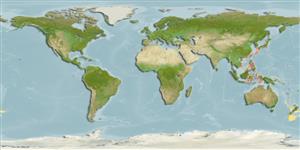Common names from other countries
Issue
In some studies Laeops tungkongensis is a junior synonym of Laeops parviceps Günther 1880.
Environment: milieu / climate zone / depth range / distribution range
Ecologia
marinhas batidemersal; intervalo de profundidade 48 - 413 m (Ref. 126083). Deep-water
Western Pacific Ocean: Philippines, New Caledonia, and Taiwan.
Tamanho / Peso / Idade
Maturity: Lm ? range ? - ? cm
Max length : 15.5 cm TL macho/indeterminado; (Ref. 311)
Raios dorsais moles (total): 97-105; Raios anais moles: 80 - 86; Vértebras: 49 - 51. This species is distinguished by the following characters: head length 5.3-6.7, body depth 3.2-3.8 in SL; upper profile without notch anterodorsal to upper margin of upper eye; snout round; length of pectoral fin of ocular side 9.5-13.1 in SL, about half of HL; upper jaw shorter than lower eye diameter; teeth 1-2 rows on lower jaw of the blind side; dorsal fin begin above nostrils of blind side, the first two rays of the dorsal fin detached from other rays of the fin; no rays prolonged; dorsal-fin pterigiophores longer than neural spines of first four caudal vertebrae; D 97-105, A 80-86, pectoral-fin rays ocular-side 14-15, blind-side 10-15, lateral line scales 88-105; gill rakers 0-2 + 6-8, vertebrae 11 + 38-40 (Ref. 126083).
Known only from a depth of 296 m. Feeds on benthic animals.
Life cycle and mating behavior
Maturidade | Reprodução | Desova | Ovos | Fecundidade | Larvas
Voronina, E.P., J. Maclaine, S. Raredon and P. Pruvost, 2020. Revised diagnoses, nomenclature, distribution and key for identification of the species of the Indo-Pacific genus Laeops (Bothidae). J. Ichthyol. 60(6),801-827. (Ref. 126083)
Categoria na Lista Vermelha da IUCN (Ref. 130435)
CITES (Ref. 128078)
Not Evaluated
Ameaça para o homem
Harmless
Utilização humana
Pescarias: sem interesse
Mais informação
Nomes comunsSinónimosMetabolismoPredadoresEcotoxicologiaReproduçãoMaturidadeDesovaFecundidadeOvosDesenvolvimento dos ovos
Idade/TamanhoCrescimentoComprimento-pesoComprimento-comprimentoFrequência de comprimentoMorfometriaMorfologiaLarvasDinâmica larvarRecrutamentoAbundância
ReferênciasAquaculturaPerfil para aquaculturaEstirpesGenéticaElectrophoresesHereditariedadeDoençasProcessamentoMass conversion
ColaboradoresFotografiasStamps, Coins Misc.SonsCiguateraVelocidadeTipo de nataçãoÁrea branquialOutras referênciasCérebrosVisão
Ferramentas
Relatórios especiais
Descarregue XML
Fontes da internet
Estimates based on models
Preferred temperature (Ref.
115969): 6.3 - 10.7, mean 8.1 (based on 192 cells).
Phylogenetic diversity index (Ref.
82804): PD
50 = 0.5001 [Uniqueness, from 0.5 = low to 2.0 = high].
Bayesian length-weight: a=0.00912 (0.00408 - 0.02036), b=3.05 (2.87 - 3.23), in cm Total Length, based on LWR estimates for this (Sub)family-body shape (Ref.
93245).
Nível Trófico (Ref.
69278): 3.5 ±0.37 se; based on food items.
Resiliência (Ref.
120179): Médio, tempo mínimo de duplicação da população 1,4 - 4,4 anos (Assuming tmax>3).
Fishing Vulnerability (Ref.
59153): Low vulnerability (10 of 100).
